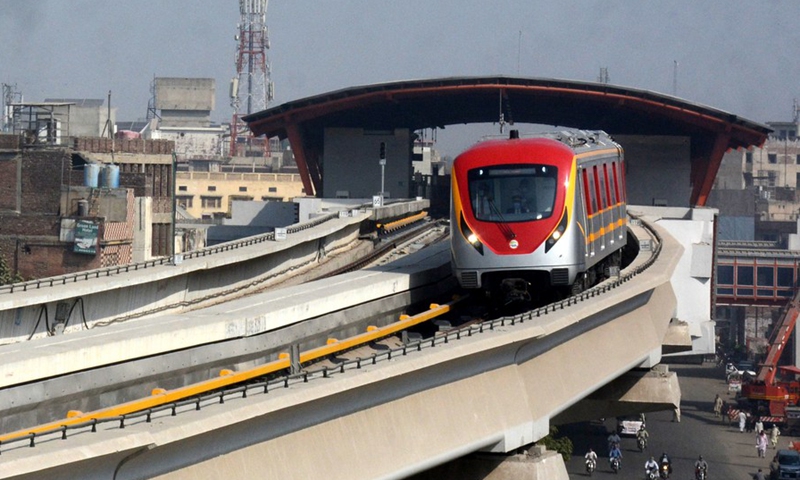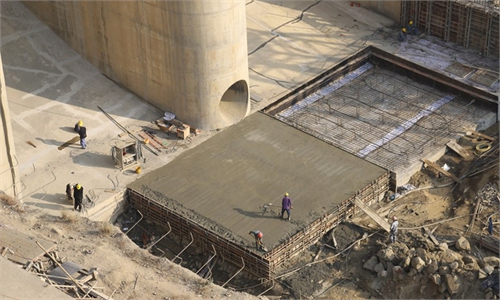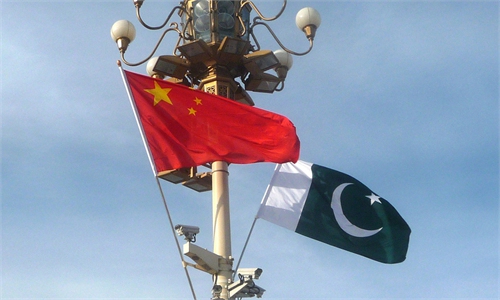
Photo taken on Nov. 8, 2020 shows an Orange Line metro train leaving a station in Pakistan's eastern city of Lahore. (Photo by Sajjad/Xinhua)
Upgradation of the Pakistan Railway's Mainline-I, which runs north to south connecting the country, is envisaged under the multibillion dollar China-Pakistan Economic Corridor (CPEC) - a flagship project of the Belt and Road Initiative (BRI). The goal is to revamp and modernize the dilapidated railway infrastructure of Pakistan. The project has great strategic importance for Pakistan and China, as it would revive the backbone of the railway network. The project was declared a "strategic project" by the Joint Cooperation Committee (JCC) of CPEC in 2017. It, thus, reflects a high-level consensus between leadership and policymakers of both countries.Significance of the ML-I project can be gauged from the fact that Pakistan's present railway track and allied infrastructure were initiated during the 19th century under the British Raj. In 1947, at the time of independence, Pakistan inherited the same infrastructure and continued to run it. Now population dynamics have changed and along with it the infrastructure has degraded as it is a 150 year old system.
A modern railway network is a strategic requirement of Pakistan's economy and supply chain systems. It will improve logistics transportation systems, save transportation time, promote connectivity and improve the quality of travel across the country.
The goal of connectivity through CPEC is unachievable without upgrading the ML-1 of Pakistan railways. The upgradation and expansion of ML-1 is, thus, considered as a big milestone in the improvement and modernization of Pakistan railways.
ML-I spans nearly 1,872 kilometers. The estimated cost of expansion and reconstruction of the ML-1 projects is $6.8 billion.
In 2015, technical experts from both China and Pakistan undertook a joint feasibility study. It was carried out by China Railway Eryuan Engineering Group Corporation, Ltd, NESPAK and PRACS. The report from the feasibility study was deliberated at the JCC in 2017, and at that time, the committee approved the study and gave a go-ahead for the next stage of the project i.e., realizing financial close and finalizing the design and other technical details.
Under the proposed framework, the ML-I project consists of three packages: first, to upgrade the track between Lala Musa to Lahore, Lahore to Multan, and Nawab Shah to Rohri. The second package will focus on modernization of the track between Lala Musa and Rawalpindi, Nowshera-Peshawar and Hyderabad Karachi section. The third package will focus on upgradation of Multan Khanewal to Sukkur section.
After the upgradation and completion of the project, the entire track will be a modern dual track. The speed of passenger trains will increase from existing 65-110 kilometers per hour to 160 kilometers per hour, while freight trains will be able to run at the speed of 120 kilometer per hour. Moreover, Pakistan railways will have a computer based signaling and control system, reducing inefficiencies and accidents, while grade separation will be implemented to ensure the safety of train operations.
It was in 2017 that JCC agreed to undertake the project and the framework agreement was signed in May, 2017 during the visit to Beijing of then Prime Minister Nawab Sharif. Since then, both sides have remained engaged in talks for financial closure, with work not yet commenced. For three years, both sides have negotiated on the estimated cost of the project and mode of financing.
Earlier, it was suggested that the project would cost more than $8 billion. This was an expensive undertaking for Pakistan, as the federal government had initially approved the project cost of $7.2 billion over eight years. Pakistan sought to reduce the cost. In 2020, both sides agreed to a reduce projected cost of $6.8 billion and the Executive Committee of the National Economic Council approved the project in August 2020.
Next, talks commenced for exploring financing arrangements for the project. Pakistan sought government concessional loan from China on low-interest rates in the USD denomination, as it considers ML-I a strategic project for both sides. China proposed a combination of commercial and concessional loans, with mix of RMB and USD components. The interest rates in Pakistan's proposed financing facility are lower than the China proposed arrangement.
Given Pakistan's current economic challenges, partly owing to the impact of the COVID-19 pandemic, it will be a difficult undertaking for Pakistan to make timely payments if it takes commercial loans for the ML-I project. It would also lead to delays in the implementation of the project and possible cost overruns. Already the start of the project has been delayed for over four years. Given ML-I is a strategic project and consensus was reached between the leaders of two countries, it is important that both sides address such issues in a timely manner for early commencement of the construction of the project.
In September, 10th JCC was held virtually and the two sides reviewed progress on CPEC projects. Pakistan and China also reviewed progress on ML-I project and decided to remain engaged on finalizing its financing arrangements. As both countries consider ML-I a strategic project, it would be in their common interest for both to display flexibility and finalize the financing mechanism through a proactive approach.
After its completion ML-I will play a major role in enhancing connectivity and supporting new economic activity. Pakistan has already proposed extension of ML-I to the Torkham border and onwards to Afghanistan. The Chinese side has expressed interest in exploring such an extension. When materialized, ML-I it will inevitably enhance connectivity with Afghanistan, Central Asia and directly enhance Pakistan and China's trade with Iran, Turkey and Central Asia and go on to become a success story of the BRI. Besides, ML-I will be cherished as China's major contribution toward Pakistan and its people's well being from an old and time tested friend. Both Pakistan and China still rejoice and take pride in the joint venture construction of the Karakoram Highway; ML-I would be an additional feather in the cap.
Muhammad Faisal is a research fellow at the Institute of Strategic Studies Islamabad (ISSI). Muhammad Iqbal is a Junior Consultant at the ISSI. opinion@globaltimes.com.cn


